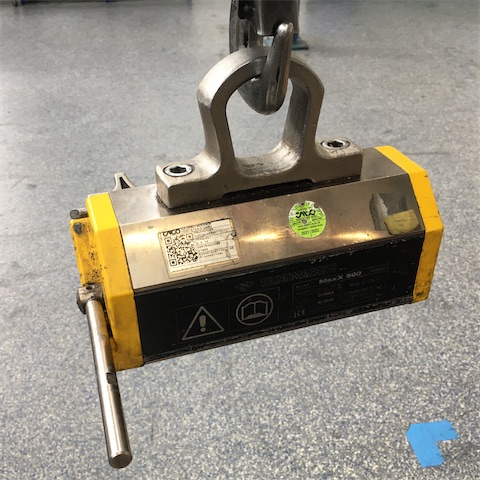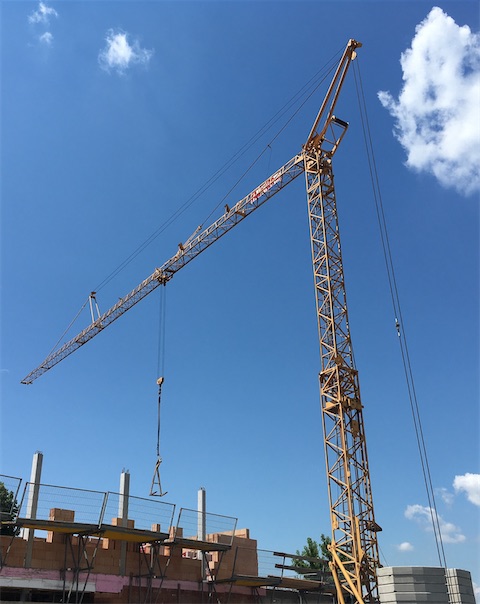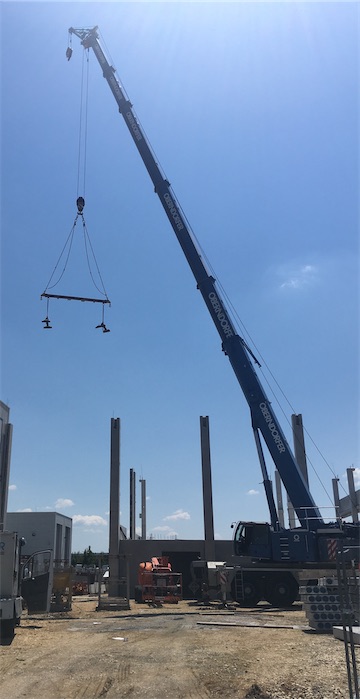Lifting Accessories DIN EN 13155
DefinitionsStandard DIN EN 13155
Load lifting attachements intended for up to 16 000 duty cycles must hold twice their nominal load without permanent deformation, and must also not drop tripple their nominal load even when permanently deformed. For more than 16 000 duty cycles, strength and fatigue must be accounted for, as is done for cranes.
This standard has special requirements for the following type of non-fixed lifting attachements:
- Plate clamps,
- vaccum lifters,
- lifting magnets,
- C-hooks,
- lifting forks,
- lifting beams,
- clamps,
- lifting insert systems.
Every lifting attachement as well as chains, ropes, and webbing for lifting must bear a type plate with CE-mark. Maximum allowable load must be indicated on each such accessory. Various types have additional marking requirements.
Machinery Directive
Lifting attachements, chains, ropes, and webbing must fulfill essential safety and health requirements set forth by Machinery Directive 2006/42/EC – MD, even though most of these accessories do not have moving parts and only some have a drive system.
Annex I of MD has additional requirements for lifting operations. OEM must prepare same Technical File for lifting attachements, chains, ropes, and webbing, as it they were a machine, in order to document conformity with MD. This file shall contain, among others:
- Description,
- assembly drawing,
- risk assessment,
- static proof and/or test records,
- operations instructions,
- EC Declaration of Conformity.
I shall be glad to assist in conception, functional safety, and documentation, especially of the following active non-fixed lifting attachements:
- Lifting magnets,
- vaccuum lifters,
- pneumatic or hydraulic grippers and clamps.
Do not hesitate to reach out for competent advice from independent engineering consultant Wolfgang Grassberger, chartered engineer.
Definition of Terms
Back to requirements of EN 13155- Hoisting machines
- Machines for lifting, carrying, transport of loads.
Examples:- Slewing jib cranes, mobile cranes, gantry cranes;
- manipulators;
- winches and hoists;
- capstans, mooring winches.
- Load suspension device
- Subcategories:
- Suspension element;
- Chaines, ropes, slings, webbing;
- Load lifting attachements.
- Suspension element
- Integral part of a hoisting machine, for attaching either one of:
- chaines, ropes, slings, webbing;
- load lifting attachements; or
- load.
- Crane hook;
- Steel wire rope.
- Chaines, ropes, slings, webbing, for lifting
- Detacheable connection between suspension element and either one of:
- Load, or
- load lifting attachement.
- Slings;
- steel wire ropes;
- chains;
- shackles.
- Non-fixed load lifting attachements
- Not an integral part of a hoist, classified as passive or active, form-fitting or non-positive.
- Passive load lifting attachements
- No drive system, cannot take up or release a load on its own.
Examples:- C-hook, coil-hook, lifting fork;
- (plate-)clamp;
- load beam, lifting cross;
- bucket, ladle.
- Active load lifting attachements
- Has a drive and can thereby take-up or release a load on its own.
Examples:- Vacuum lifter (self-priming or non-self-priming);
- lifting magnets (permanent or electro-permanent),
- pneumatic clamps.
- (Suspended) access equipment
- Suspended from lifting elements, hoisted by lifting equipement, sometimes integrated in load lifting attachements.
Examples:- Man cages/crane platform cages;
- suspended work platforms;
- concrete placement bucket with riding platform.




